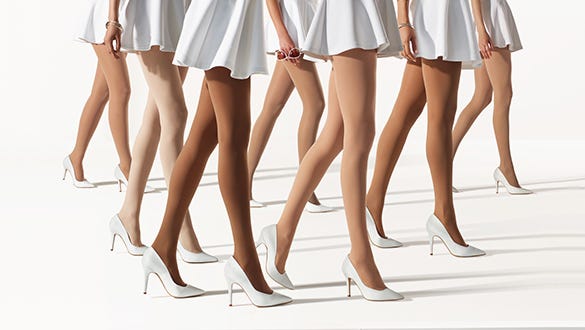- Free First Class Delivery
- Buyer Protection
- Secure Online Shopping
- Healthcare Professional? Click here
Thread veins


Categories
Thread veins (medical term: telangiectasias): Tiny visible veins under the skin
Thread veins, also called spider veins, are fine, visible, tiny veins in the top layer of the skin. Thread veins are dilated, surface veins in the leg located in the skin’s upper layer. The individual thread veins are often only a few centimetres long but can also cover large areas of the upper and lower leg like a spider’s web. Small thread veins are light red in colour. They are harmless and mostly just a cosmetic/aesthetic issue. However, they can be the first sign of chronic venous disease, which can later result in varicose veins, among other things. Consult your doctor.
Causes: What causes thread veins?


- Thread vein and varicose veins are caused by the same things:
Owing to a functional weakness of the bicuspid valves in the veins, the blood in the veins – i.e. the blood that is low in oxygen – no longer flows directly towards the heart. - The blood accumulates in the leg where it raises the pressure on the vein wall (= venous hypertension).
- Congestion occurs in the veins that are affected by this and the walls become stretched.
Thread veins at a young age: A warning sign for later years
- It’s possible to get thread veins quite young, as early as 20 years old. With increasing age, distinct varicose veins, swollen legs and skin changes can also occur. In a worst-case scenario, a venous leg ulcer can develop as a result of the vein weakness. Patients with vein weaknesses also have an increased risk of developing deep vein thrombosis.
- Experts estimate that around 60 % of the population may suffer with thread veins*. Unfortunately, women are more susceptible to experience this condition more than men.
Symptoms and signs: Thread veins look like this


Thread veins can appear on the upper leg, knee, hollow of the knee, lower leg (particularly calf and ankle) and on the foot. They are not painful. If varicose veins and other symptoms also occur, this may indicate a more serious venous disorder. Signs and symptoms to be aware of:
- Tired legs
- Heavy legs
- Swollen legs
- Feeling of tightness
- Tingling in the legs
- Pain in the legs
Thread veins often first appear during pregnancy
Many women first notice thread veins or varicose veins during pregnancy. The venous wall is weakened by hormones released during pregnancy. As the expectant mother gains weight, her body produces more blood and the pressure in her veins increases.
Compression stockings by medi that support you during your pregnancy:
Risk factors for developing thread veins
The risk factors for thread veins are comparable with those of a classic varicose vein condition. Experts state some issues are hereditary but other factors can be reduced by leading a healthy lifestyle.
Factors that cannot be influenced include:
- age-related loss of vein function,
- genetic predisposition and
- hormonal influences that lead to weakening of the venous wall, for example during pregnancy.
Factors that can be influenced include:
- primarily sitting or standing activities,
- being overweight,
- alcohol consumption or
- tight clothing and high heels.
Preventing or limiting thread veins
One of the most effective ways to prevent thread veins is to be proactive in your leg care. Follow these tips to reduce the risk of developing thread veins:
- Exercise: Lying down and walking is better than sitting and standing: Move regularly, changing your position.
- Sport and exercise: Plan ten minutes of leg exercises into your everyday routine to activate your calf muscle pump.
- Healthy diet: Follow a healthy, balanced diet.
- Optimise your weight: Reduce any excess weight, as this can cause additional strain on your legs and circulation.
- Clothing: Wear comfortable, loose clothing.
- Shoes: Choose comfortable, flat shoes so that your calf muscle pump is able to work effectively.
- Showers: Rinse your legs in cold water regularly. This helps the veins contract and improves the blood flow to the heart.
Treatment and removal of thread veins
From a distance, the skin areas affected by thread veins look like bruises; the mesh structure of the tiny veins is only visible if you look more closely. If the appearance of thread veins bothers you, there are several ways of removing them:
- Sclerotherapy for thread veins: Treating the smallest surface veins with sclerotherapy (microsclerotherapy is currently the first choice method).
- Laser treatment for thread veins: Laser treatment is possible for very small, not very pronounced thread veins (percutaneous laser therapy).
Patients with thread veins may suffer with other signs and symptoms of a chronic venous condition: If your legs feel heavy and/or tired, itchy or tingly, if you have a feeling of tightness or tend to have swollen legs then medical compression stockings may ease your symptoms.
Medical compression stockings are particularly effective in combination with exercise. Regularly wearing medical compression stockings eases symptoms and can prevent thrombosis.
Which doctors treat thread veins?
You should consult your GP in the outset. If necessary you will be referred to a vein specialist (phlebologist). Phlebologists specialise in the diagnosis and treatment of vascular diseases, particularly venous diseases.


Thanks to their breathable, stretchy material, medical compression stockings are very comfortable for men and women to wear and often people would be unaware that your garment is providing additional support to your circulation. There are a wide variety of innovative and effective products, with different fabric strengths, colours and styles available to meet your individual needs as a patient. Wearing compression stockings and with modern technological advances in thread vein treatments, mean there are solutions to this condition.
*Rabe E et al. Bonner Venenstudie der Deutschen Gesellschaft für Phlebologie. Phlebologie 2003;32:1–14.














